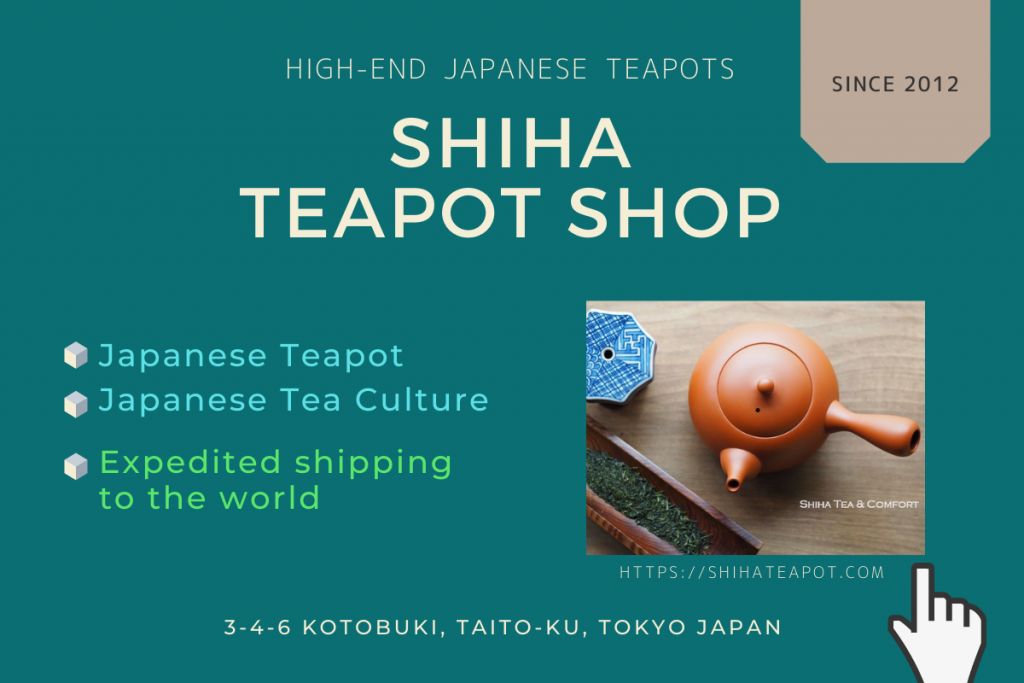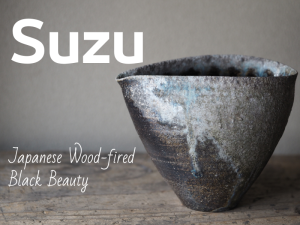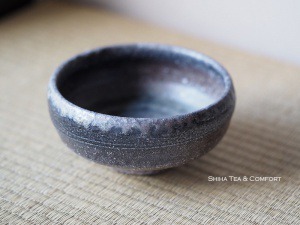【What is SUZUYAKI? 】Beautiful Black Pottery in Japan, Woke up from a 500-year sleep About 珠洲焼 (SUZU WARE)
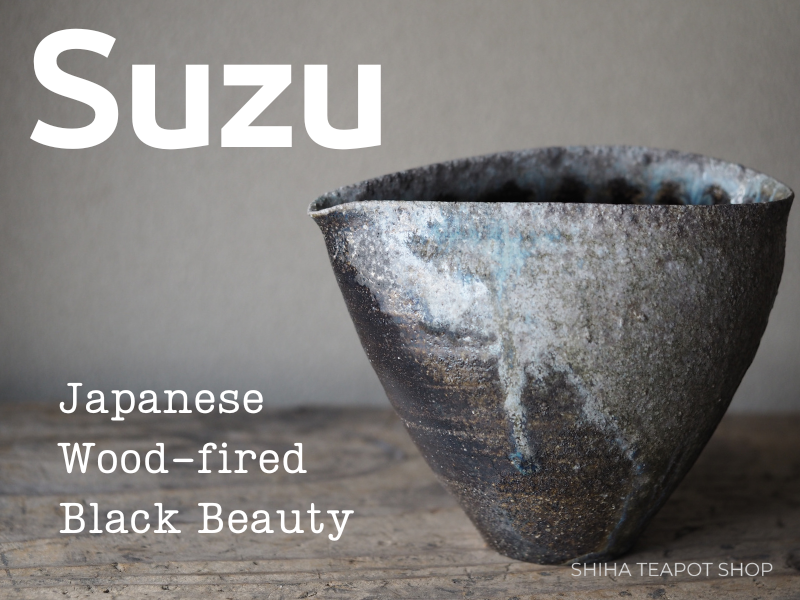
Hello, We are SHIHA TEAPOT SHOP in Japan. This is the story of Suzu ware (Suzu-yaki) . We introduce beauty of Suzu-yaki, comparing modern and medieval Suzu-yaki.
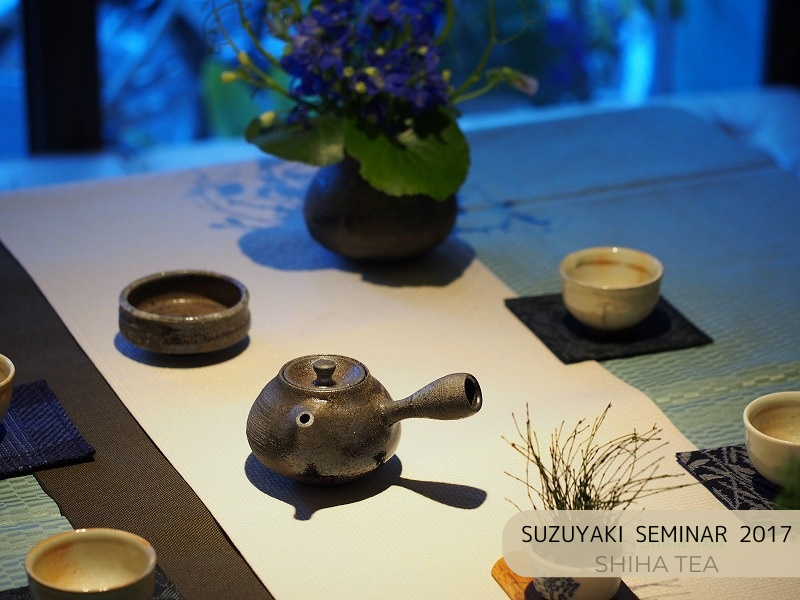
Contents 目次
- SUZUYAKI News – January 2024
- What is Suzu-yaki?
- SUZU – Land of Beautiful Black
- Modern Suzu-yaki
- Medieval Suzu-yaki
- SUZUYAKI: The Recovery Progress After Earthquakes and Floods (2022-2025)
- SUZUYAKI: Earthquake Damage and Recovery News Articls (2022-2023)
- SUZUYAKI: Noto Peninsula Earthquake – Damage and Reconstruction News (2024)
- Message from Shinohara Takashi – February 2025
- Support and Donation for Suzu City and SUZU Pottery Artist
SUZUYAKI News – January 2024
Huge Earthquake Hits Noto Peninsula, Place of Suzuyaki on January 1st of 2024.
Tragically, Suzuyaki Pottery Artist, Shinohara Takashi’s kiln collapsed due to the erthquake. This kiln had just been rebuilt from the collapse from the previous earthquake (occured in May 2023). It is said that the kilns of the most of Suzu Pottery artists were destroyed.The follwoing article report the situation of Shinohara Takashi’s kiln.
What is Suzu-yaki?
Suzu-yaki is a black unglazed pottery made in Suzu City, where is located Noto Peninsula in Ishikawa Prefecture. It is classified as stoneware. It is a traditional craft of Ishikawa prefecture. Suzu is the name of the place, “-yaki” literally means “fired” (pottery). Suzu-yaki means pottery made in Suzu, which are with local clay and fired in reduction atmosphere (black body).
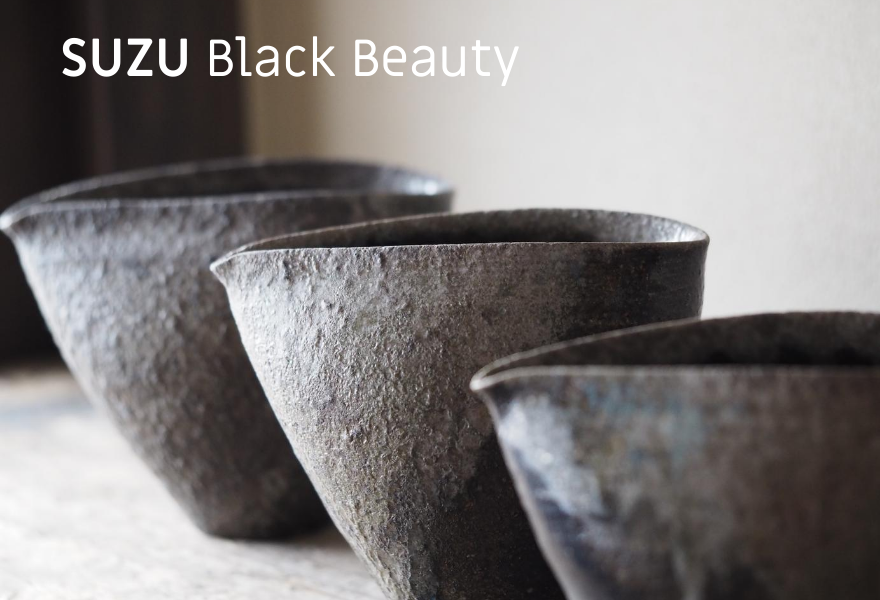
SUZU – Land of Beautiful Black
Suzu is a beautiful black town. On the road from Noto Airport in Ishikawa Prefecture to Suzu city, and here and there, you can see the beautiful black tiles that decorate the roof of the house. (Noto tile) When you visit Suzu city, you will be immersed in the beautiful black world created by this land.
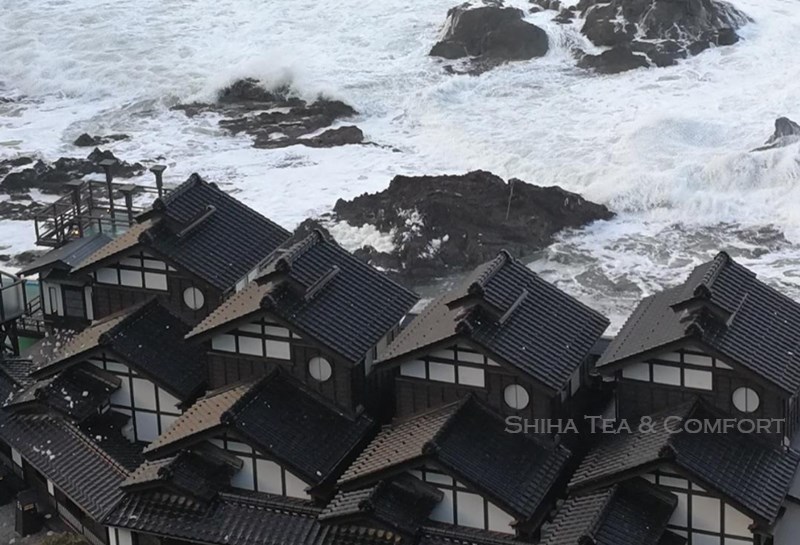

There is also a lot of green, and you can feel the contrast with black vividly.
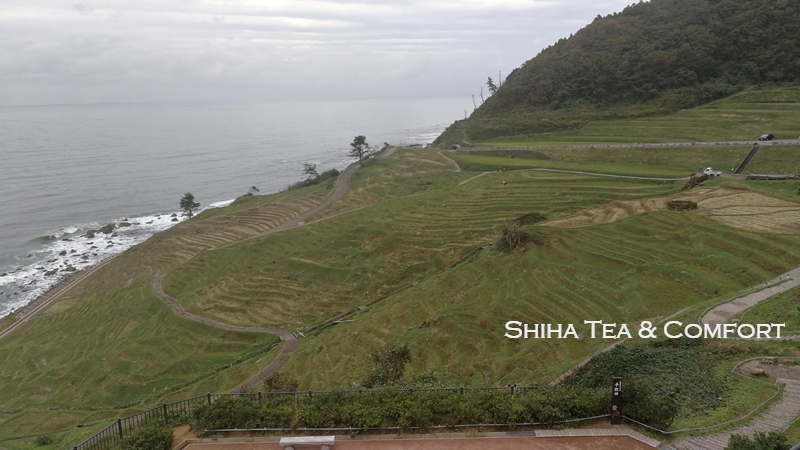
It is a view from the highest mountain in Suzu. (November)
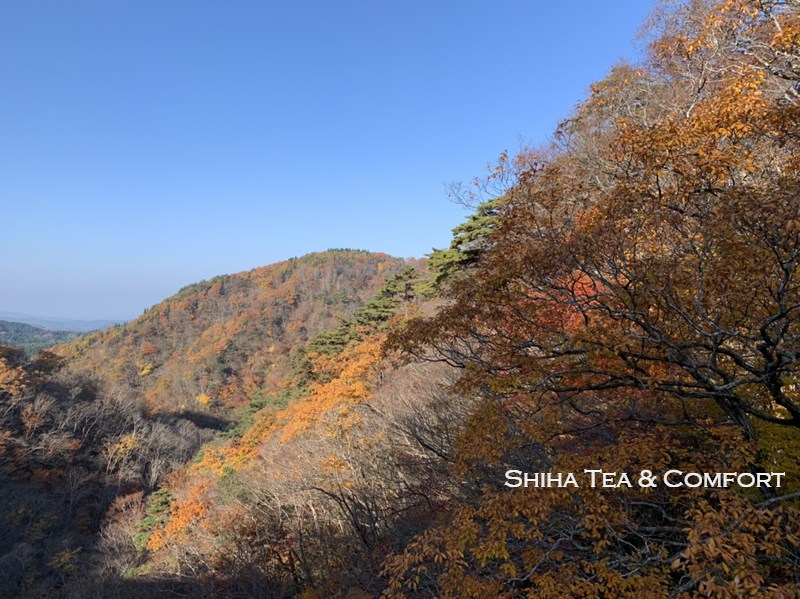
Suzu is a place where you can enjoy fresh foods, history and culture, nature and ceramics, such as diatomaceous earth, Jomon archaeological sites, rice, seafood, sake, salt, nature, sea, and wind. The roads are wide and few people, so driving and cycling are comfortable.

Modern Suzu-yaki
The Secret of Quiet Beauty
Suzu-yaki that are fired in a wood-fired kiln have natural glazes such as gray, green, and pink. A deep layer of soft color are created on a black background. (Some works are fired in a gas kiln.)
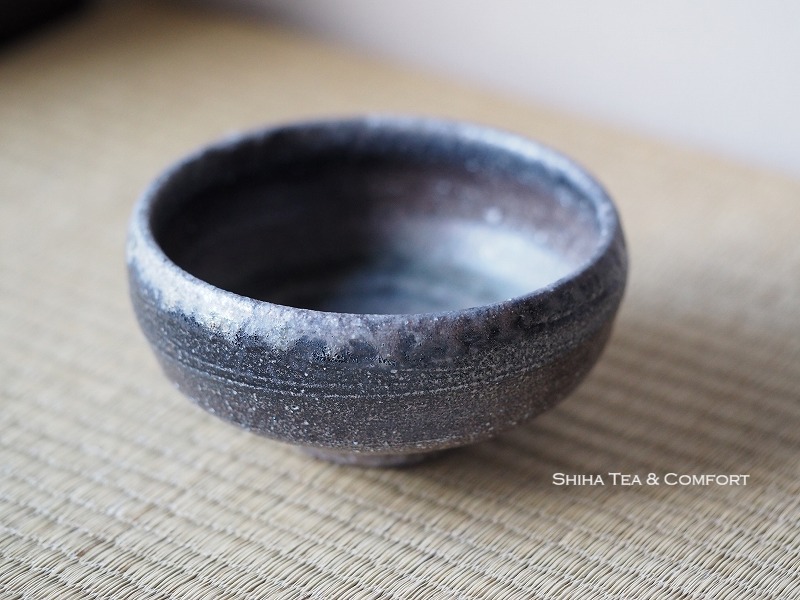
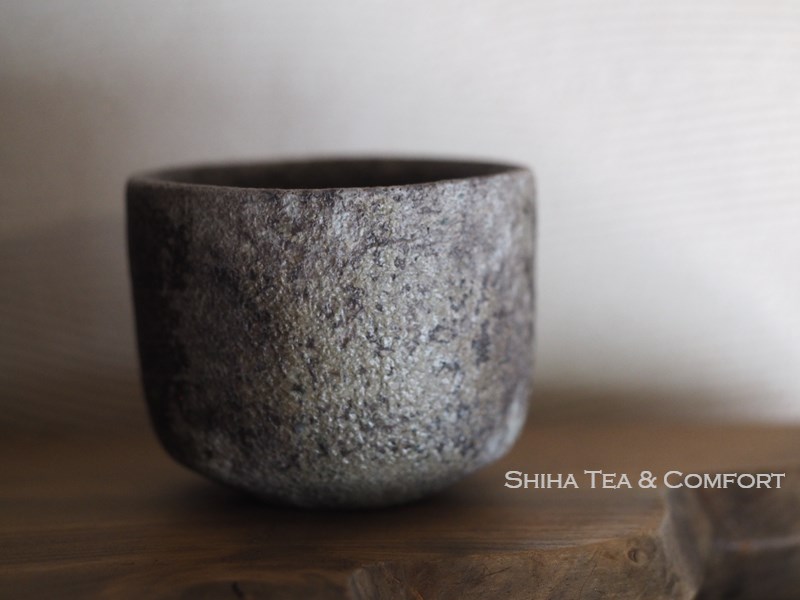
When fired pots in a kiln, if firewood is used as fuel, the firewood (pine trees, etc.) will be burned and become ash, which will fall on the pots in the kiln. It creates beautiful colors and complex textures.
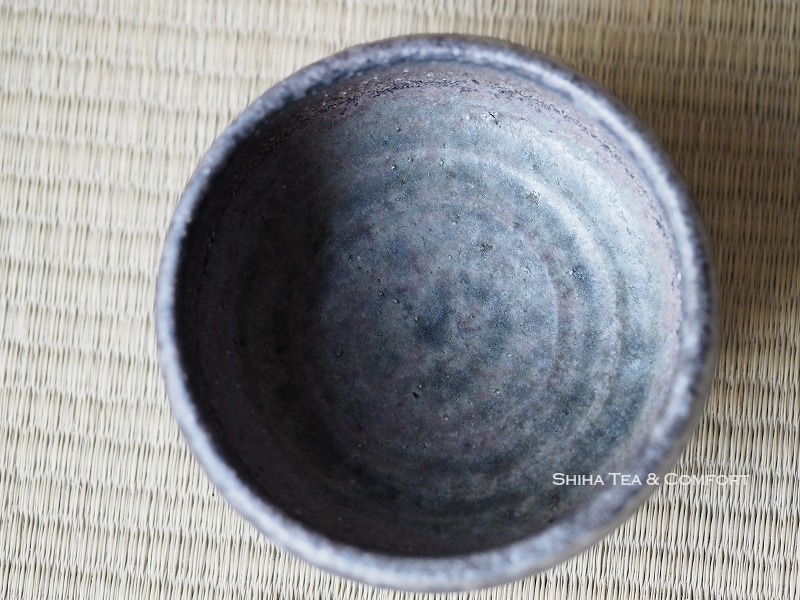
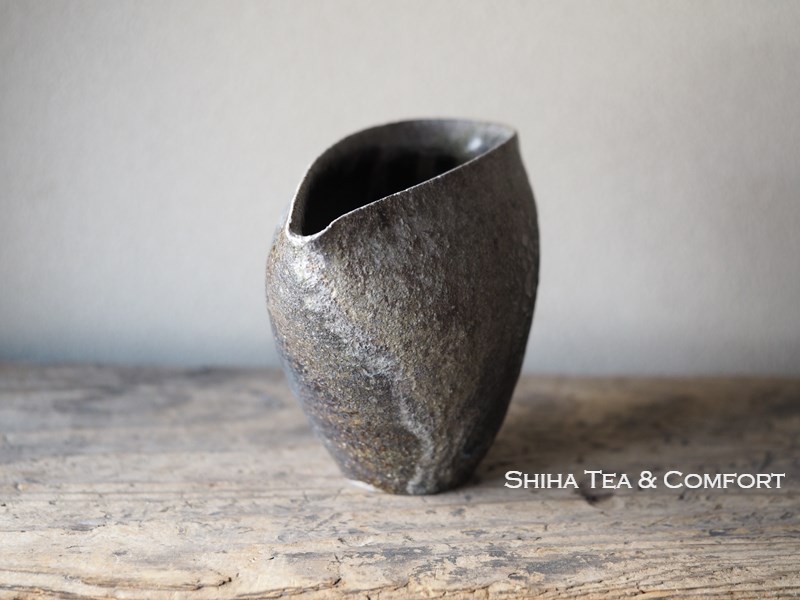
The works in this chapter and the next chapter are the wokrs of artist SHINOHARA TAKASHI.
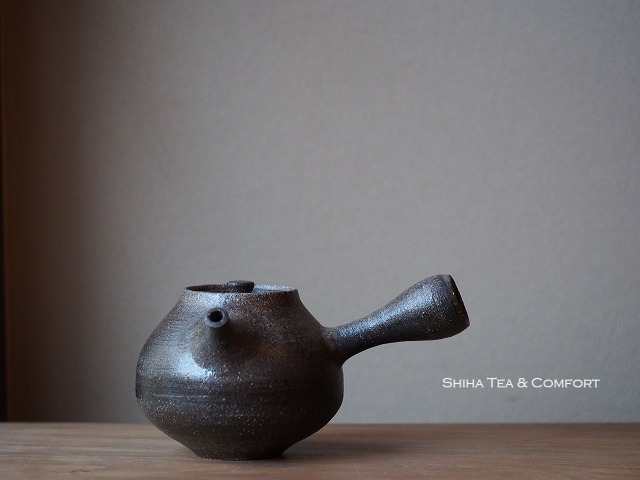

The Clay of SUZU
There are no clay shops in Suzu. So, artists in Suzu walk through the mountains and find their own clay.
What kind of clay is required?
First, it must have plasticity – in other words, it should be sticky and moldable.
Second, it must be fire-resistant. Since we fire the pottery at over 1200°C, the clay must withstand high temperatures.
Mr. Shinohara explain more in the video.
Kiln Firing (Mr. Takashi Shinohara’s wood-fired kiln)
Firing wood for 24 hours x-days is hard work, but there is a unique beauty created by wood-fired kiln.
We asked Mr. Shinohara about the firing. It is described in the upper and lower parts of the video. Please also see the amount of firewood used in the video.
Introduction of the video: (Mr. Shinohara explains) The video is probably when the kiln temperature is 1100℃. The series of operations as shown in the video is repeated every few minutes. The amount of firewood to be burned is determined by the condition of the kiln, but basically, I only burn as much as the kiln requires. If there is too much or too little, the temperature will drop. It is important to get this intuition.
How many days do you fire the kiln?
Four days and nights, five days in total. It is best for fuel consumption and my physical strength, but recently it often takes 5 to 6 days and nights. Longer firing results in more ash and more natural glaze flow.
How do you decide how many days (hours) of firing is enough?
The timing of when to finish firing is determined by looking at the color inside the kiln and the surface illumination of the pieces. At the same time, ash attached to the work melts and flows out, and the surface of the work begins to shine like a glass surface. At this point, I look for the right time to stop the fire.
The decision of whether to continue firing for another half day or one more day is made in consultation with my physical strength and energy, while imagining the image of the finished product.
At what stage and how does Suzu ware turn black?
When the fire is stopped, there is a hard process. Oxidizing firing kilns are finished quietly, but in the case of Suzu-yaki (reduction firing), a large amount of wood is packed into the burning chamber at the end and the entire kiln is sealed.
Wood fired in a temperature exceeding 1,200°C still seeks oxygen to burn in the sealed chamber, but because oxygen from the outside is cut off, it is also deprived of oxygen from the work.
In the process, the iron contained in the clay is reduced to produce the grayish-black color of Suzu ware. If this process is neglected, Suzu clay will have a reddish color like Bizen ware.
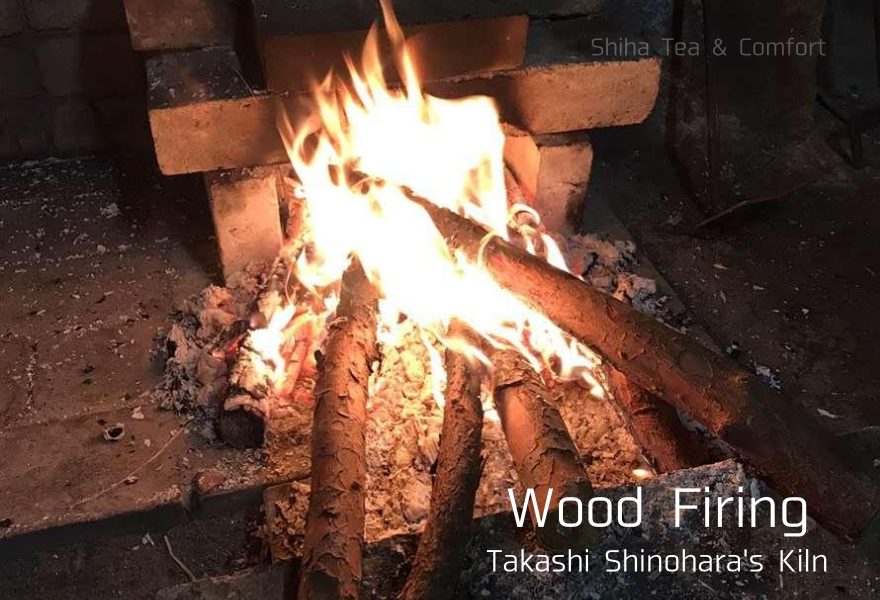
For firewood, Mr. Shinohara uses red pine or cedar depends on the cases. The color and atmosphere of the natural glaze changes depending on the type of firewood used.
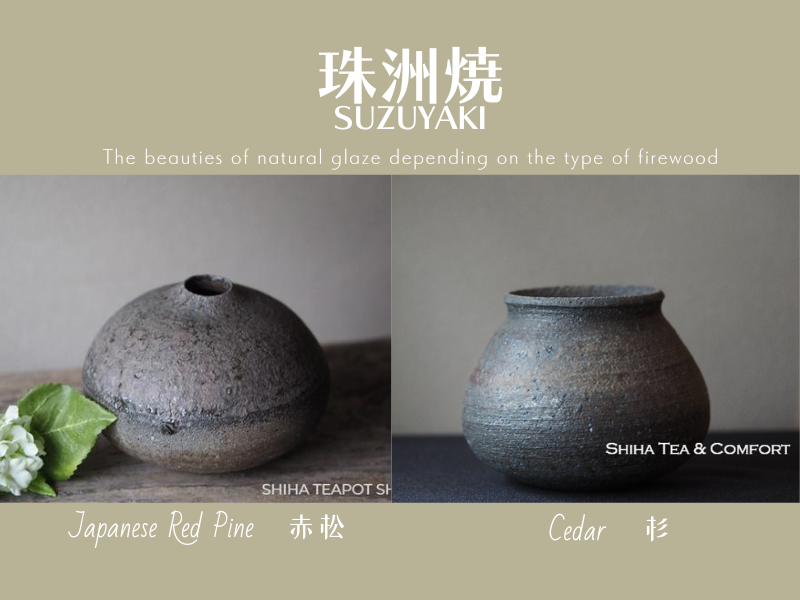

Suzu-yaki Scene
Suzu-yaki make you calm and pulpify.
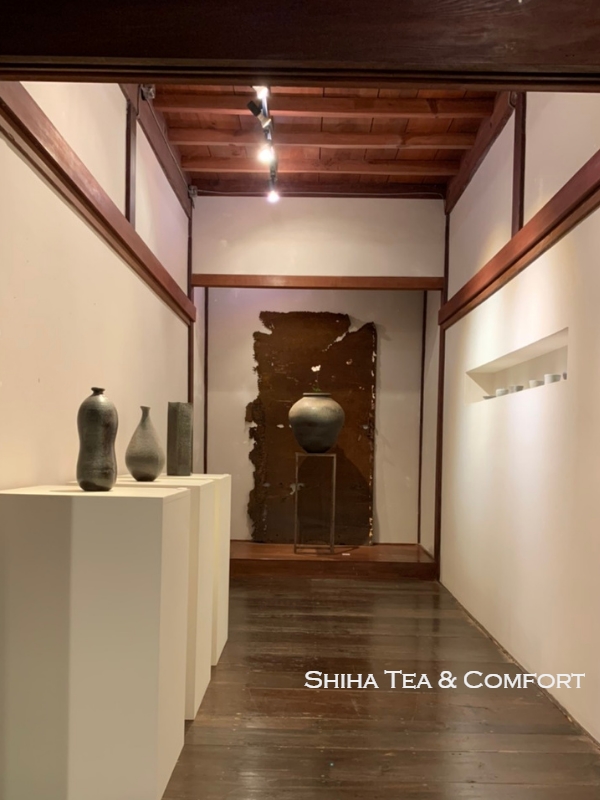
I feel that Suzu-yaki can make plants in nature look even more beautiful.
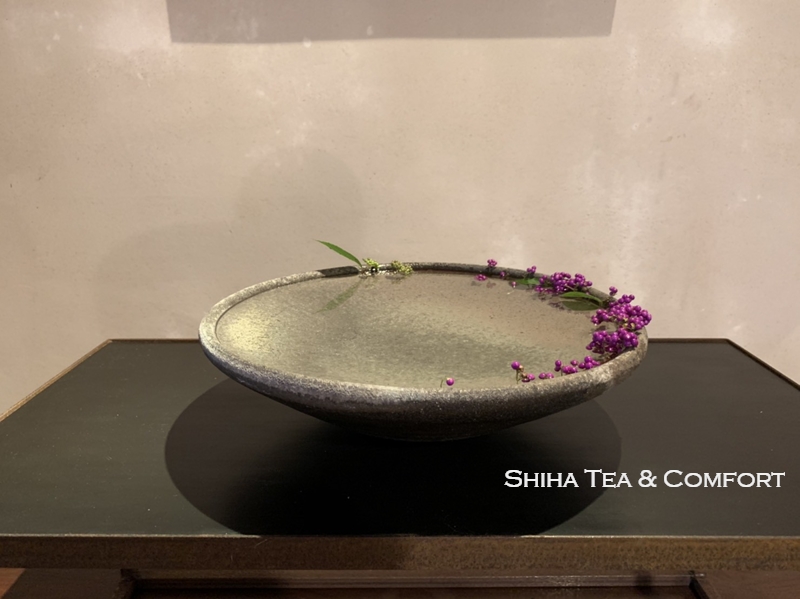

When flowers are in Suzu vase, it creates a dignified atmosphere. Please see the following blog for flowers and Suzu-yaki.
Suzu-yaki Overseas
Customers who purchased Suzu-yaki from overseas sent us photos.
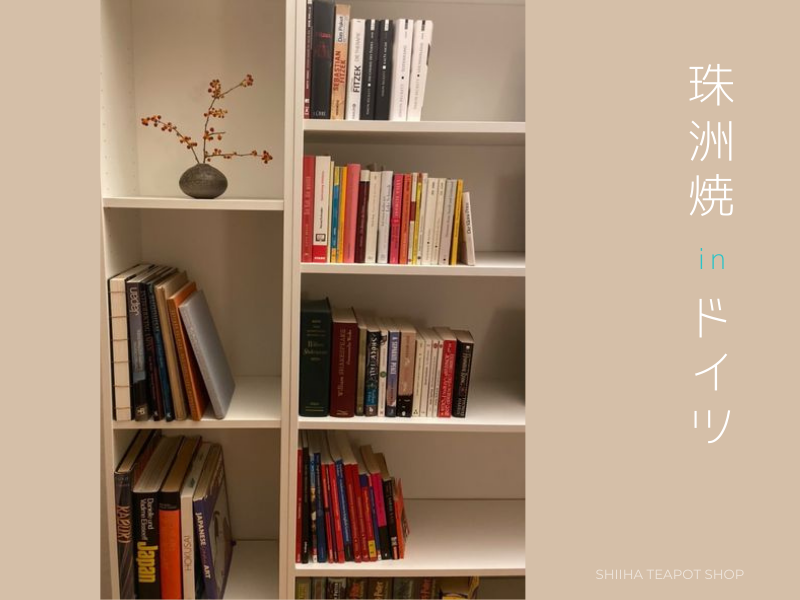
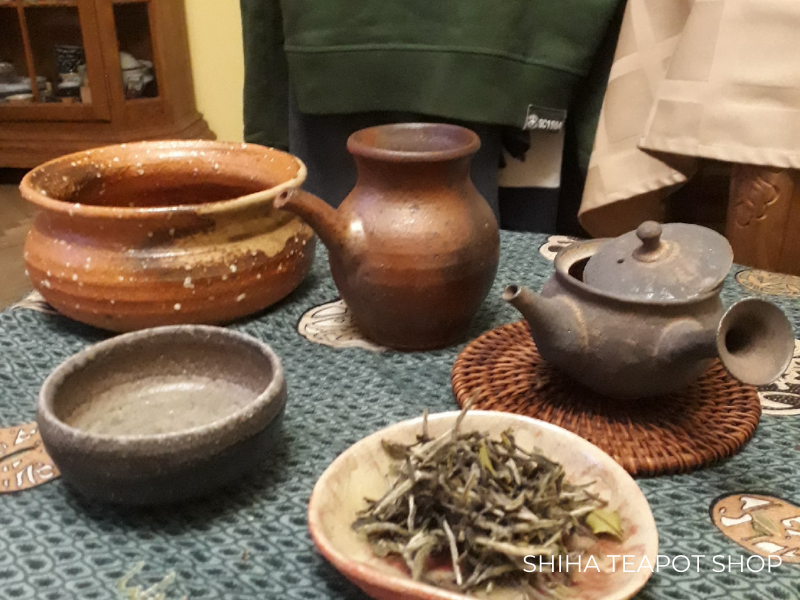
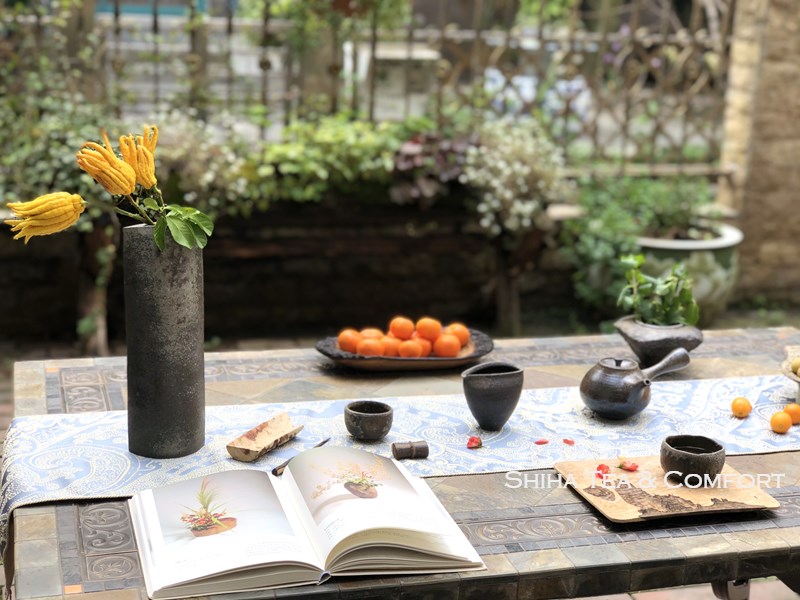
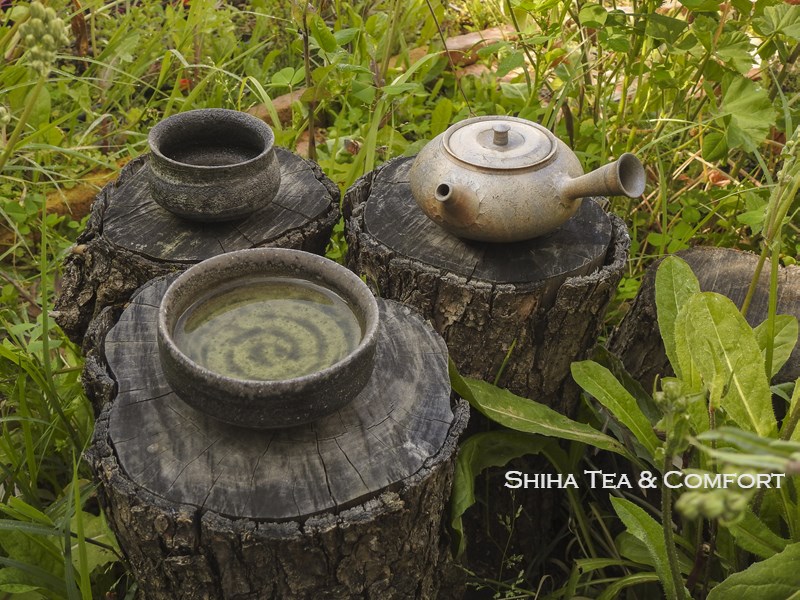
For messages from each country, please see the following Japanese Suzu-yaki lifestyle photo page.
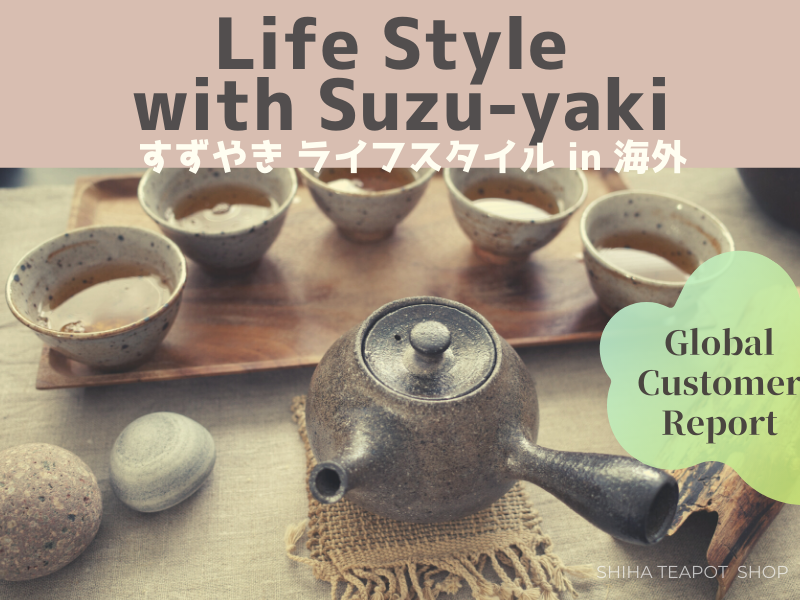
SUZU-yaki & Tea
Global tea lovers share their impression of “Suzu-yaki & Tea”. You can see the effect of Suzu-yaki for tea in the following blog. They brew Chinese tea in Suzu-yaki teapots (teacup). We are waiting for impression with Japanese Tea, as well.
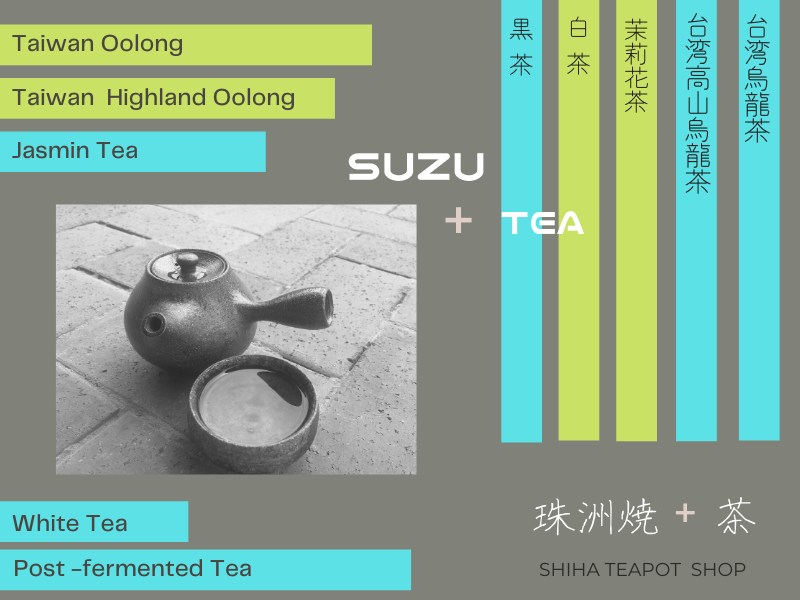
Medieval Suzu-yaki
Medieval Suzu-yaki large jars and jars were exhibited at the “Suzu-yaki exhibition” in Shibuya Hikarie (September 2019). The characteristics are the same as modern Suzu-yaki – Black, unglazed, fired in a wood-fired kiln, natural glaze. And the large jars and jars are characterized by their small bottoms. The lower body of the Kyusu teapot of Mr. Shinohara Takashi (modern Suzu-yaki) reproduces the original form of Suzu-yaki – a small and tight bottom. The sharp line toward the foot shows typical “Suzu ware”.
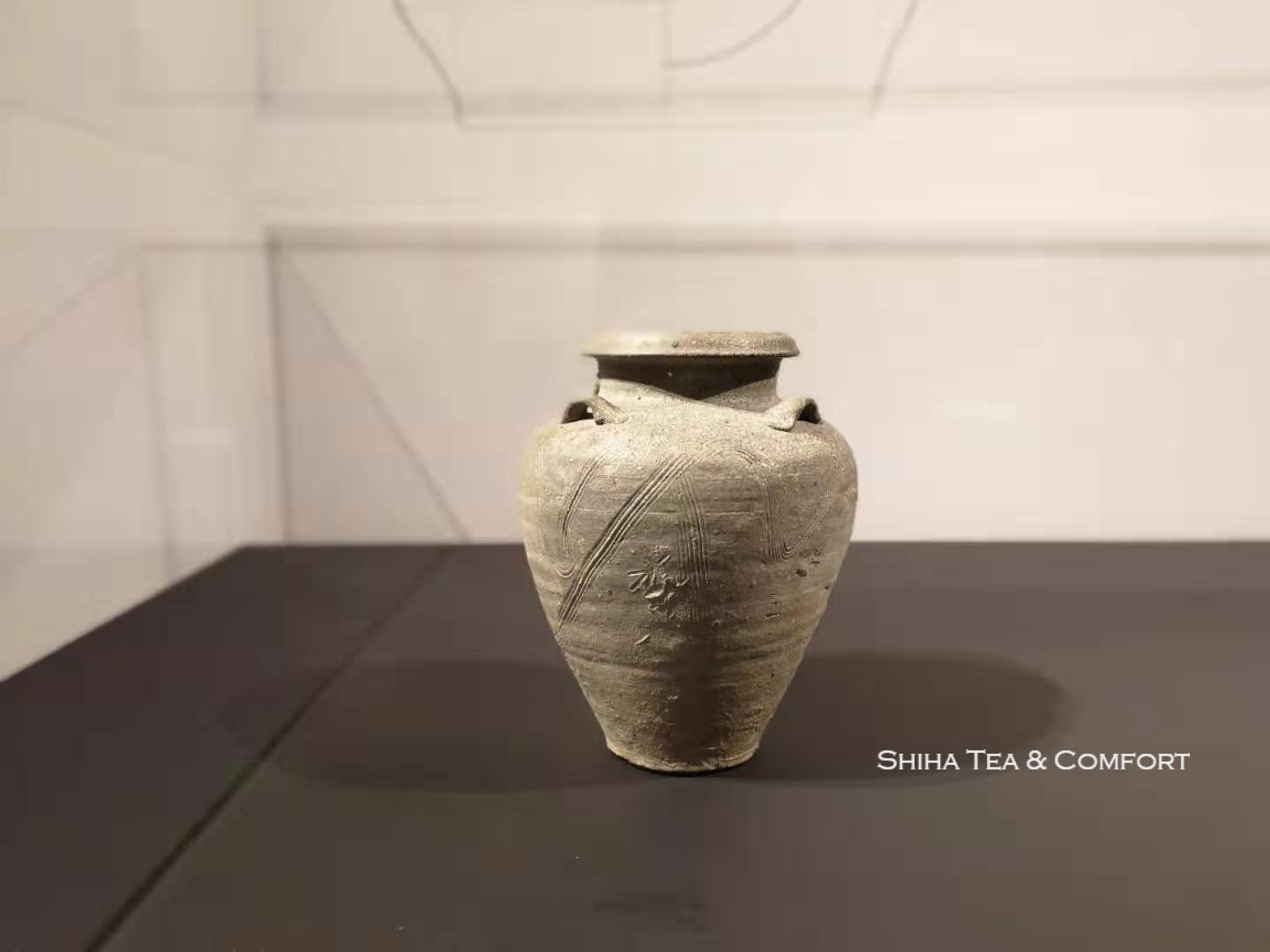
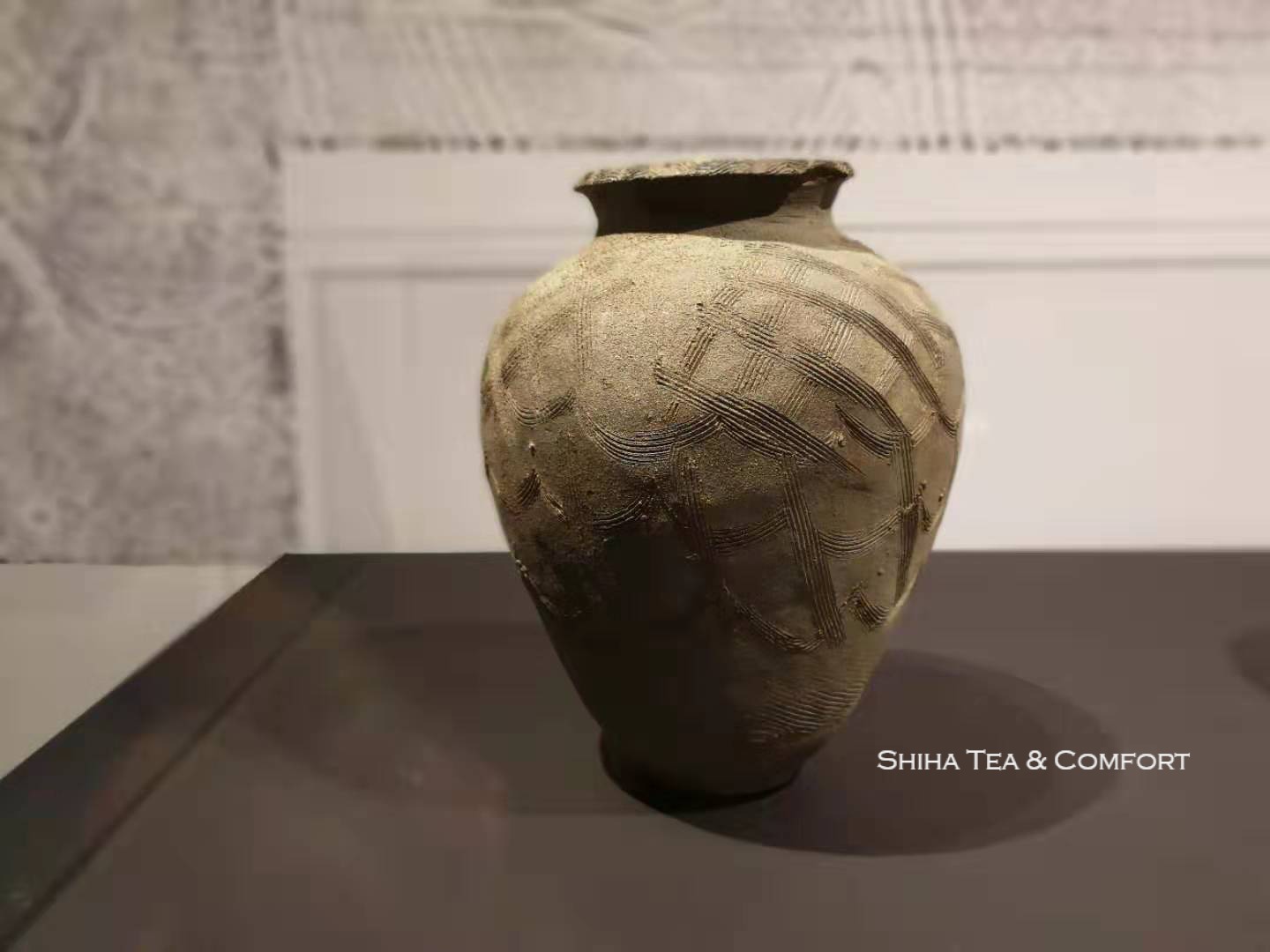
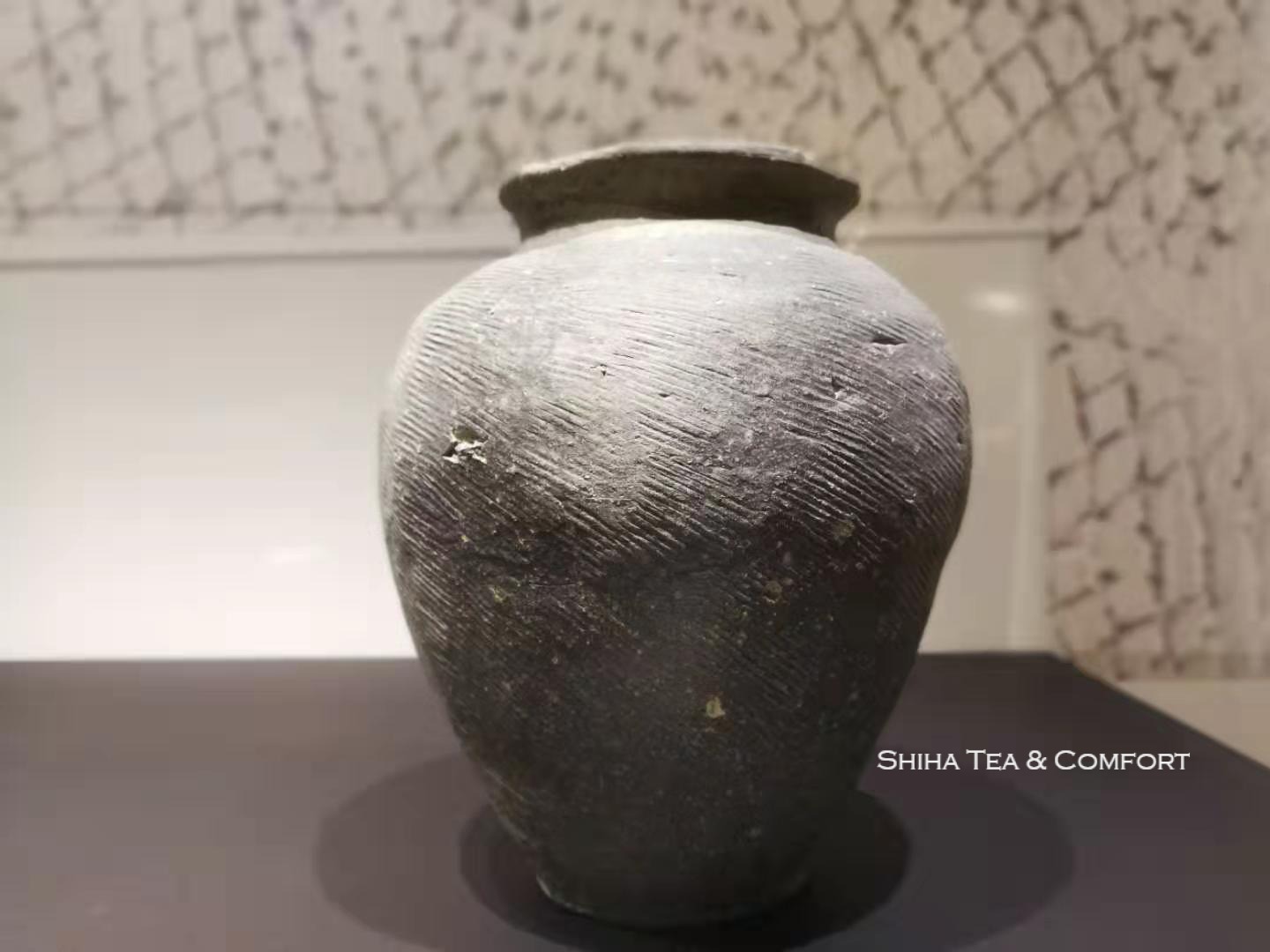
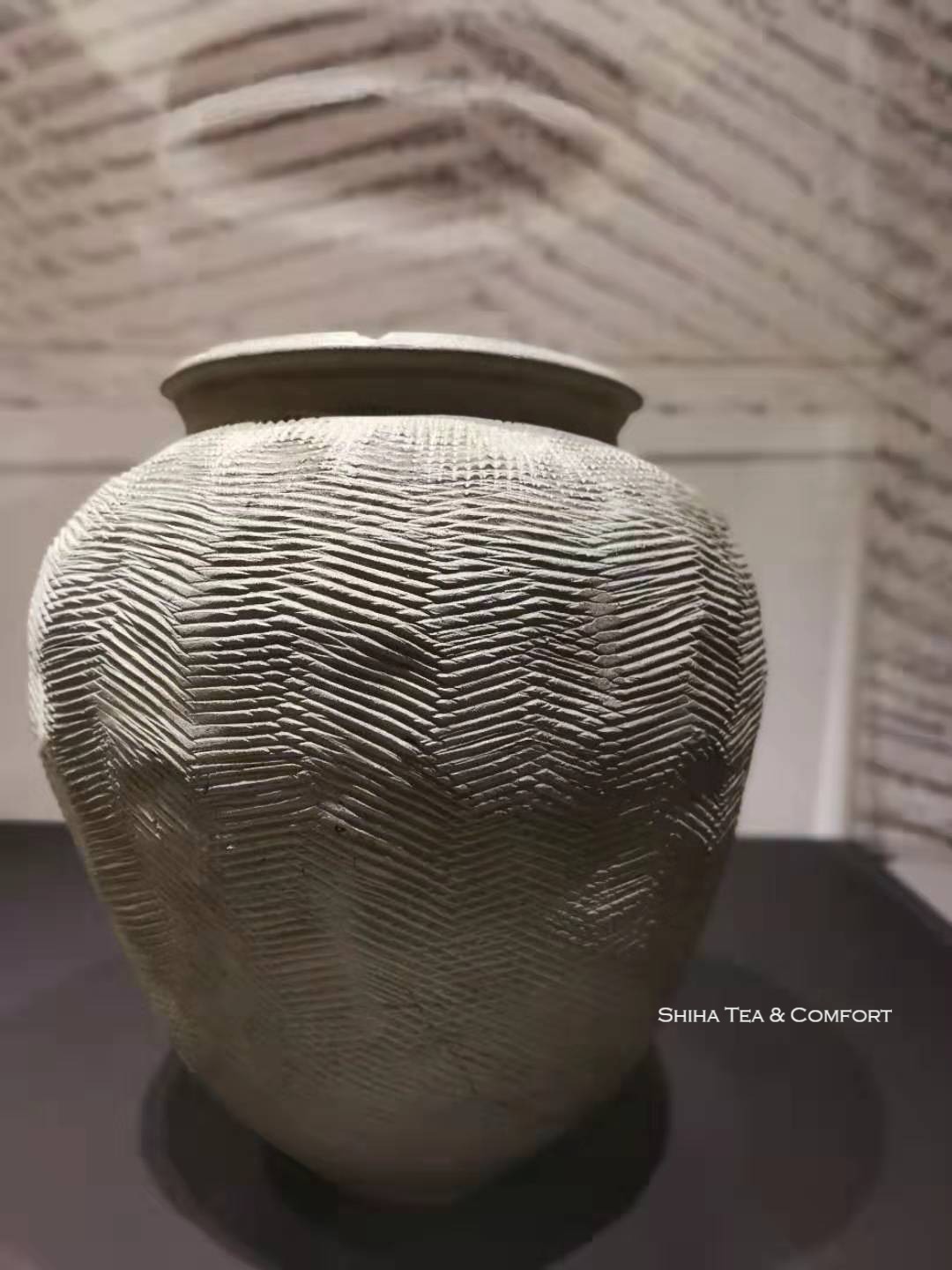
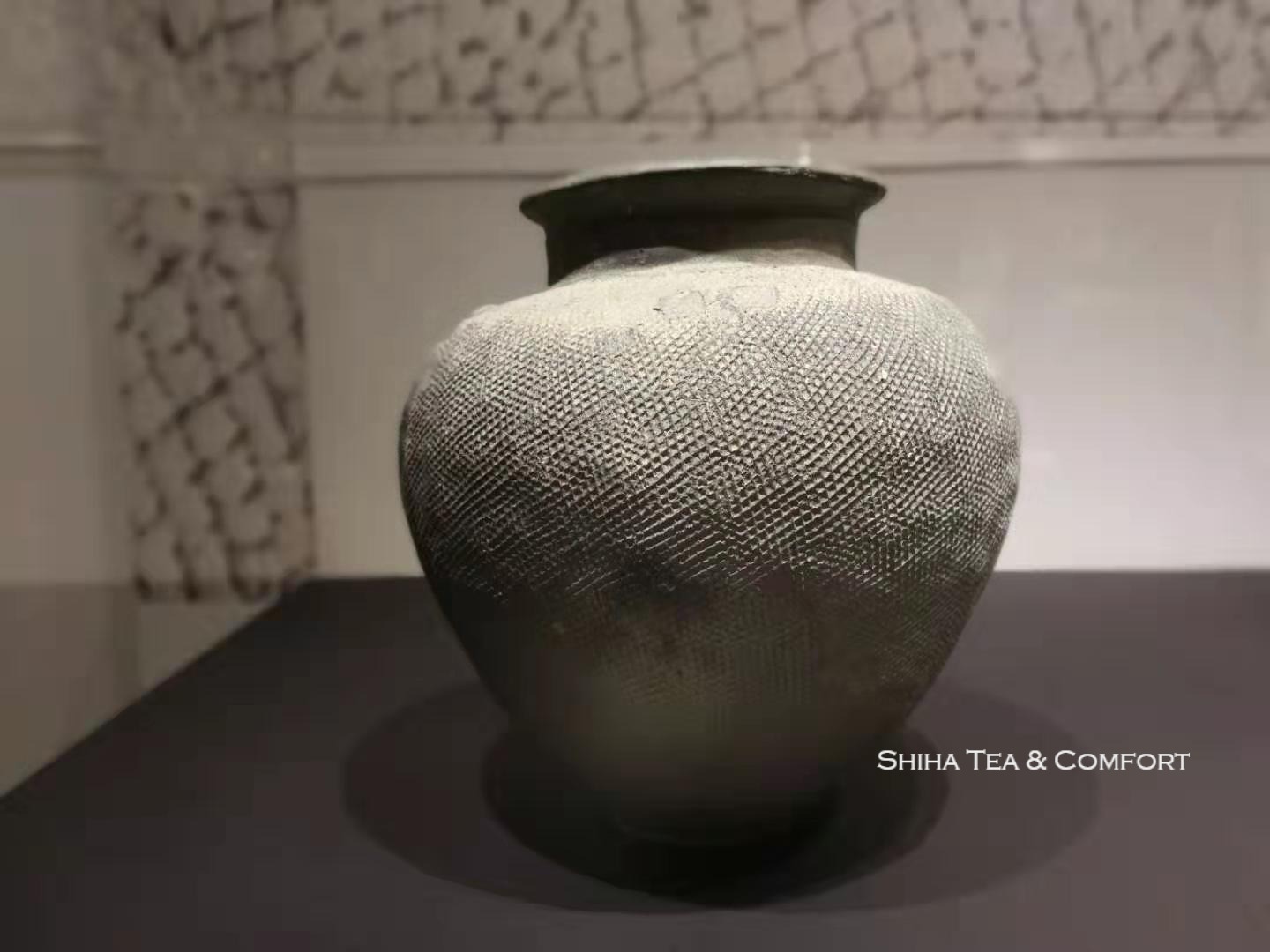
These are from the 12th to the beginning of the 15th century. The color and natural glaze in the photo are not clear due to the light, but the impression I got from the real things was still a “simple and quiet beauty”.
Ones in earlier times are more gray than black. It is said that if the raw material soil contains a lot of iron (and the temperature of the kiln is high), it will be darker. Ones in earlier were fired in lower temperature (not yet possible to have higher temperature). As close 15th century, the temperature of the kiln became higher, and deep black ones come out.
Soil/clay with a high iron content turns black by reduction fired (a state where there is little oxygen in the kiln). It turns reddish when it is oxidation firing, which has much oxygen in the kiln. Suzu-yaki is made in reduction firing.
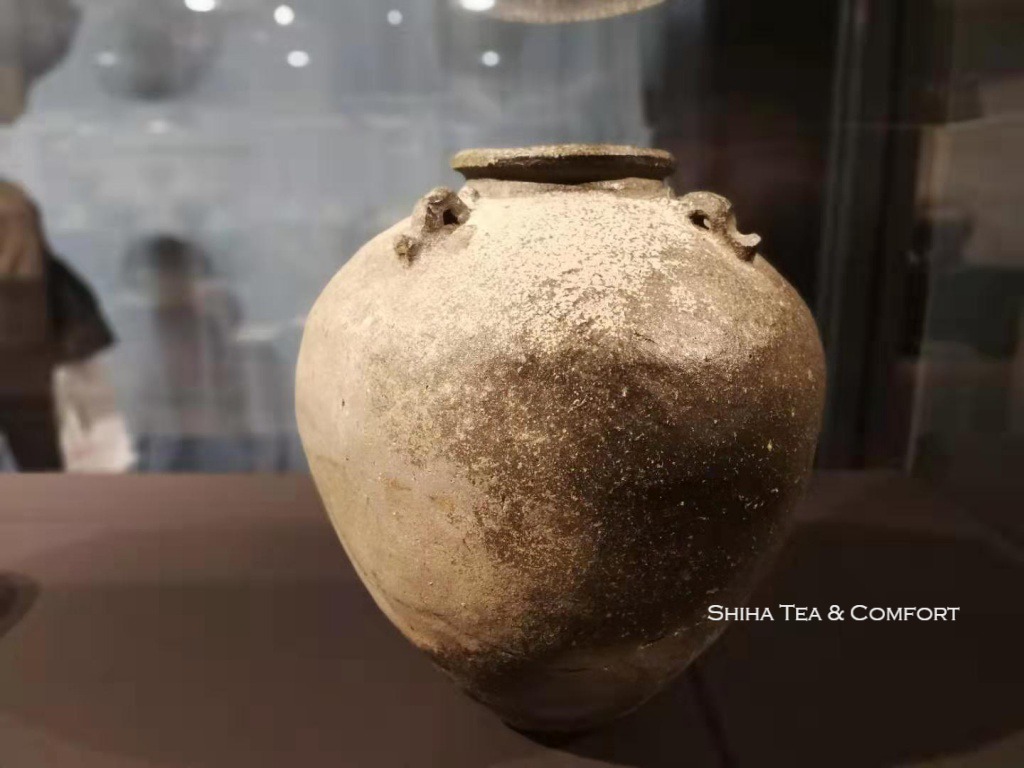
This four-ear jar had many dark parts in the body, and the surface was glossy and deep. (It’s hard to see in the photo)
Suzu-Yaki, Comparison to Other Old Potteries at Tokyo National Museum
There was a comparative exhibition of Suzu-yaki and Medieval pottery at the Tokyo National Museum(2019). By comparison, you can clearly see the characteristic of Suzu-yaki, which is black color and the tight bottom. Can you tell which one is Suzu-yaki?
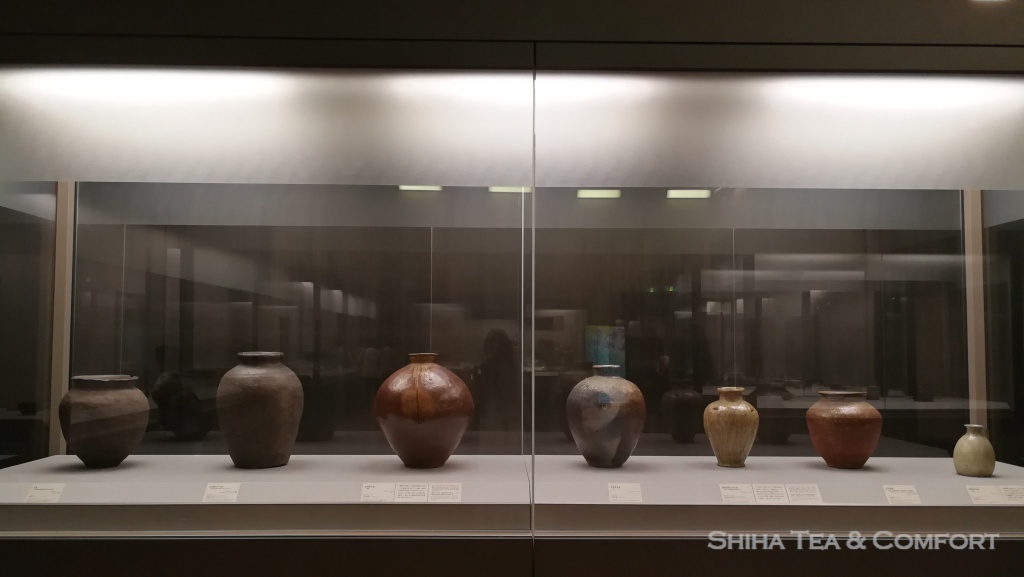
Suzu-yaki has a sharp line toward the bottom(foot).
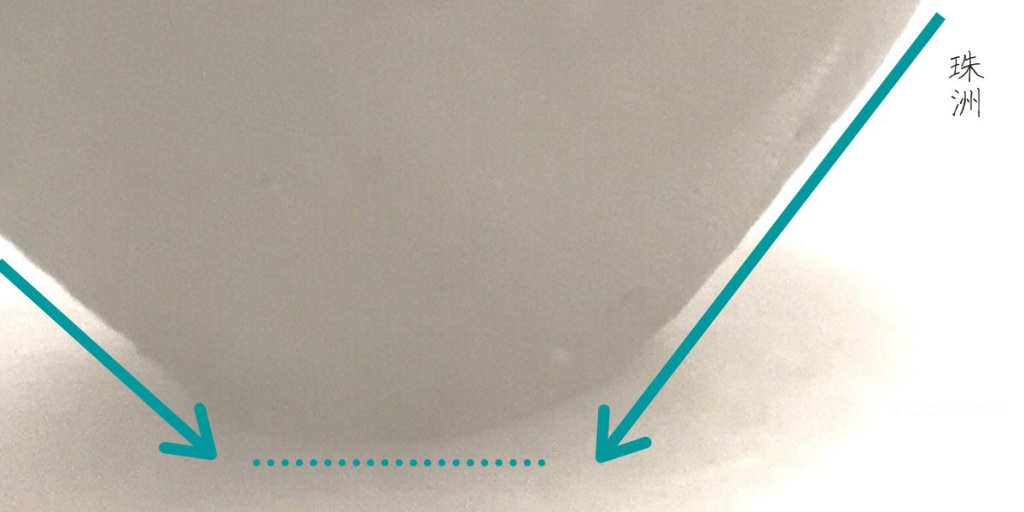
Suzu ware is on the far left. Please see the following blog for the exhibition photos of Tokyo National Museum.
By comparison, Suzu-yaki is blackish and gray. Others are reddish and brown (Bizen, Echizen, Tanba, Tokoname)
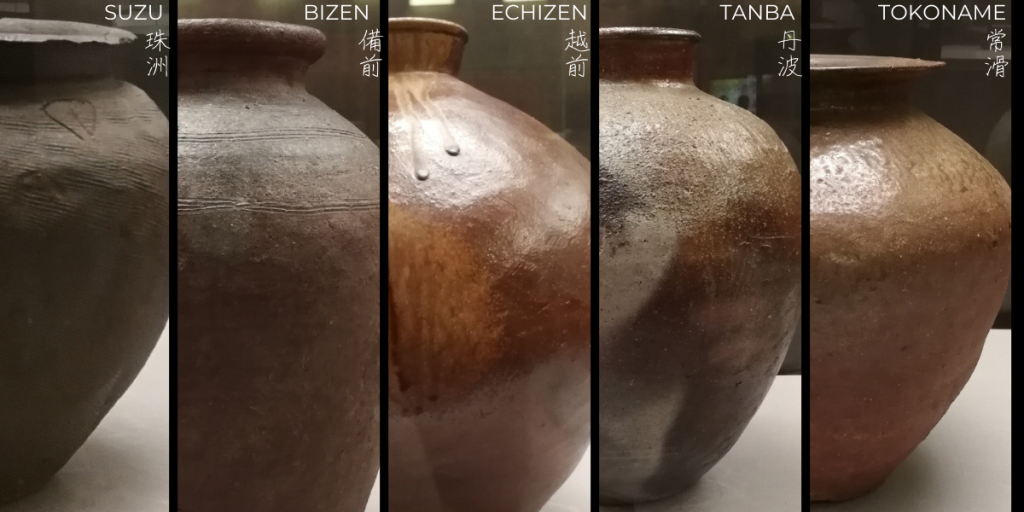
This is an explanation of the exhibition. Suzu-yaki is listed in the pottery from the Heisei-Muromachi period (medieval period) – the charm of large jars . Below is a commentary on Tokyo National Museum. (Explanation of Japanese Parts)
平安時代末の12世紀になると、産業と経済の発達にともなって古代須恵器や灰釉陶の生産技術を基礎に、各地で新しい窯場が台頭します。自然釉のかかった常滑・渥美(とこなめ・あつみ)、須恵器から展開した珠洲(すず)が中心となり、擂鉢や碗皿類のほか、壺や甕などの大型品が作られました。
Tokyo National Museum
In the 12th century, at the end of the Heian period, new kilns emerged in various places based on the production technology of ancient Sue pottery and ash-glazed pottery with the development of industry and economy.
In addition to mortars and bowls, large items such as jars were made. Tokoname & Atsumi with natural glaze, and Suzu that was developed from Sue pottery were the major production area.
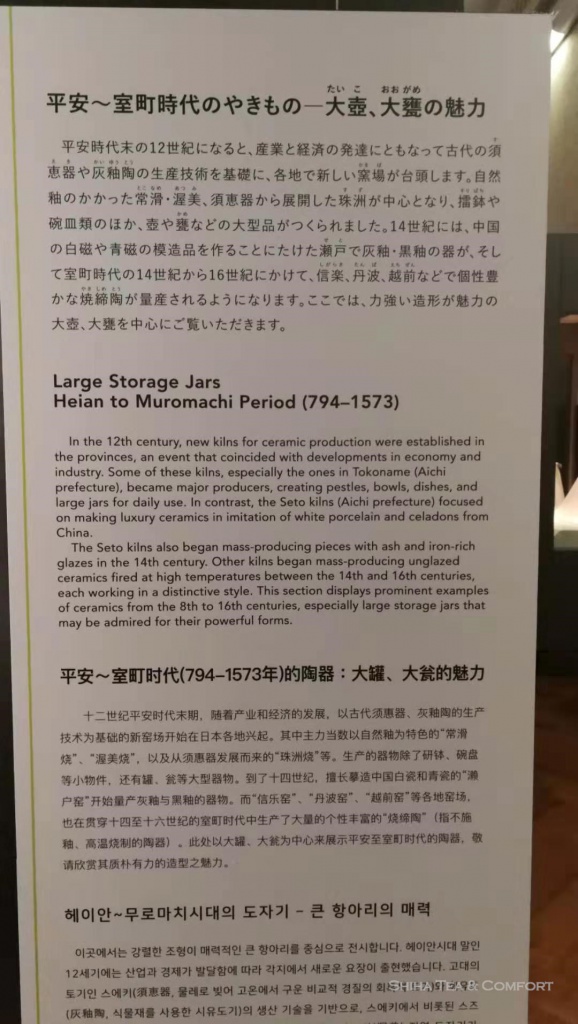
500 years of silence “phantom ancient pottery”
In fact, Suzu-yaki were suddenly disappeared in the 15th century. It was said that “it disappeared suddenly” and “phantom old pottery”. Modern Suzu-yaki was revived about 50 years ago. The existence of Suzu-yaki has not been known for a long time. It was revealed in modern times, and it has been reconstructed.
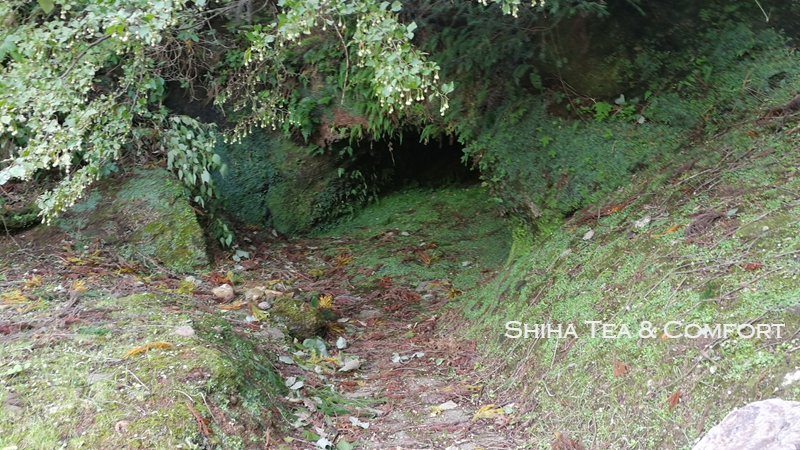
Discovery of Unknown Black Pottery, Named “Suzu-yaki” in 1961
An antique researcher’s encounter with a gray-black four-eared large jar one day. It triggered Suzu-yaki to wake up from a 500-year sleep. He went to Suzu city to explore the roots of the unknown pottery and conducted a survey with a local history researcher. Then, the pottery was found to be medieval pottery and was named “Suzu-yaki”. It was 1961 (Showa 36).
Commentary on Suzu-yaki in the Middle Ages (at year 1998)
As a fan of Suzu ware, I was delighted to hear the explanation of Suzu-yaki(excerpt below) in the history of Japanese pottery (supervised by Yoshiaki Yabe) published in 1998. However, I was worried that it was hidden in the fame of the Japan old six kilns.

この六古窯の名声に隠れて、その存在を知られていなかった古窯に…(中略)石川県珠洲市の珠洲焼がある。
にほんやきもの史 The History of Japanese pottery
Hidden in the fame of these six old kilns, there is an old kiln whose existence was unknown … (Omitted) Suzu-yaki in Suzu City, Ishikawa Prefecture.
ちなみに須恵器系の窯としては…(中略)なかでも、造形的にとくに抜きん出ているのは、やはり、石川県の珠洲焼である。その黒光りする素地肌。鋭敏なエッジを利かせた造形と、重厚な作りの大壺は人をして感動させる迫力がそなわっている。
にほんやきもの史 The History of Japanese pottery
By the way, as a Sue pottery kiln … (Omitted), the one that stands out in terms of modeling is Suzu-yaki in Ishikawa prefecture. The black shining base skin. The shape with a sharp edge and the heavy jar have the power to impress people.
In 2019, about 20 years after the publication of this book, looking at the exhibition and commentary at the Tokyo National Museum mentioned above, I feel that research has made for Suzu-yaki further and existence and scale of Suzu-yaki in the Middle Ages were clarified.
SUZUYAKI: The Recovery Progress After Earthquakes and Floods (2022-2025)
Since 2022, the Noto Peninsula has been hit by earthquakes and floods, and the city of Suzu and its pottery artists have suffered tremendous damage. The following chapters will show the progress.
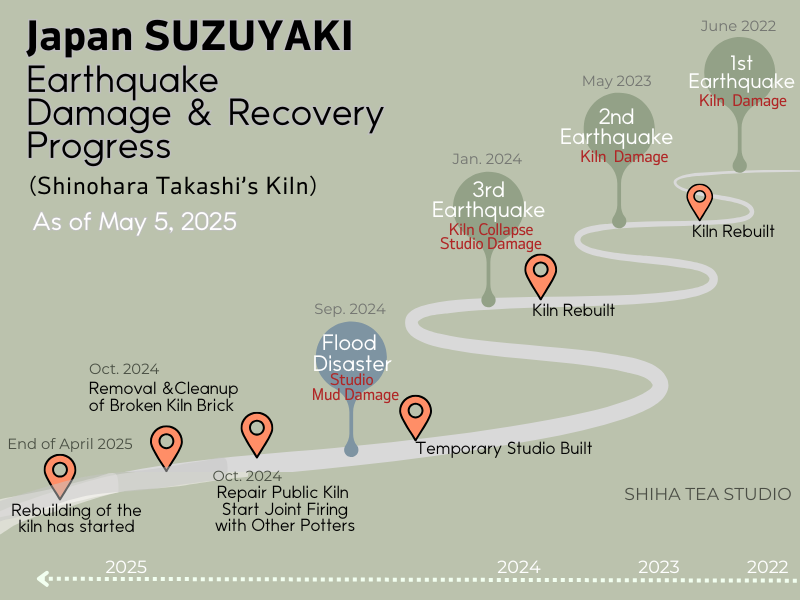
Due to repeated earthquakes and floods, the Suzuyaki pottery has suffered significant damage.
At the end of October 2024, Takashi Shinohara conducted firings of his works at a public kiln. The Suzuyaki artists as a whole have not yet recovered from the damage, and their daily lives have not returned to normal.
At the end of April 2025, Takashi Shinohara started his kiln rebuilding (Please see the news paper aritcile as of May 5, 2025 below).
SUZUYAKI: Earthquake Damage and Recovery News Articls (2022-2023)
In June 2022, a powerful earthquake struck Suzu City on the Noto Peninsula. Another earthquake followed in 2023, deeply impacting the Suzuyaki pottery artists. Many of their works were destroyed, and their kilns suffered severe damage. Just as they had begun to recover and move forward from the 2022 earthquake, they faced this new setback. Below is a link to the news article.
First Earthquake, in 2022
Jun 28, 2022: A Step toward Rebuilding SUZUYAKI Damaged by Earthquake(YouTube)
https://www.youtube.com/watch?v=GFioUdH83zo&t=7s
July 4, 2022: “Two Weeks After the Earthquake – Artists Affected Hold Exhibition ‘I Thought for a Moment About Giving Up'” (YouTube)
https://www.youtube.com/watch?v=hAntn8rKRtA&t=143s
Jan 6, 2023: “Rising Again After a Lower 6 Magnitude Earthquake – Suzuyaki Artist Takashi Shinohara’s Determination to Take a New Step” (YouTube)
https://www.youtube.com/watch?v=QLbQQz-gQzw
Second Earthquake, in 2023
May 10, 2023: Suffering of Suzu ware artists whose kilns were destroyed by the earthquake (article + video)
https://newsdig.tbs.co.jp/articles/mro/477765
May 11, 2023 Repeated major earthquakes: The struggles of affected Suzu pottery makers (YouTube)
https://www.youtube.com/watch?v=XJ6NiOFwsNM
May 16, 2023 Earthquake of magnitude 6+ damages works and kilns of the traditional craft of Suzu-yaki, two major earthquakes (Article)
https://www.fnn.jp/articles/-/527374
June 3, 2023 Takako Tokiwa becomes the leader of a support group for the recovery of Suzu ware (Article)
https://www.hokkoku.co.jp/articles/-/1087062
The photo below shows Suzuyaki artist Takashi Shinohara (of Yuge Kiln) working on the reconstruction of his wood-fired kiln in early September 2023.
For this kiln rebuilding project, Mr. Shinohara put out a nationwide call for help. In response, over 150 people from across Japan joined him in the effort, including those he had met through his work, people interested in learning more about Suzuyaki, and young aspiring potters. Thanks to their collective support, the kiln dismantling, brick cleaning, foundational work, and new bricklaying were completed from June to August 2023.
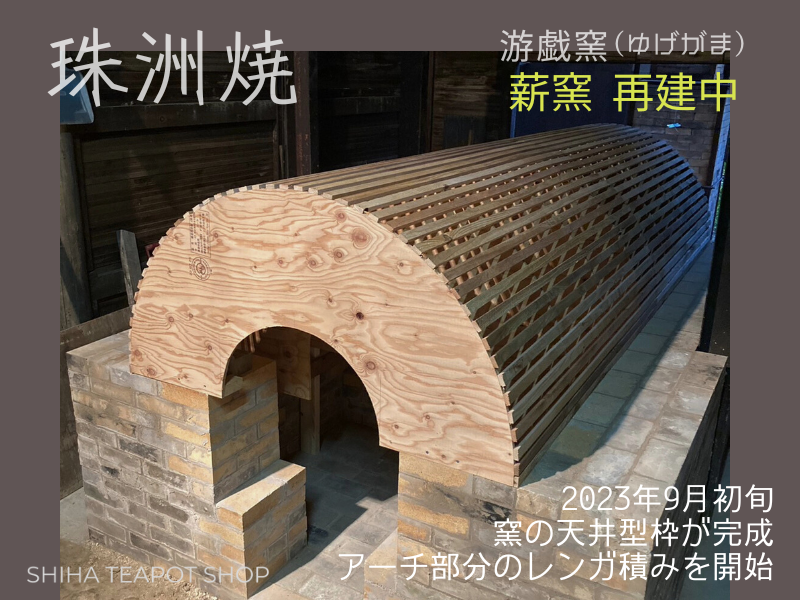
As of November 2023, Suzuyaki artists are actively working toward resuming their creative activities.
Nov 5, 2023: Kiln Rebuilt, Light Shines on Suzuyaki Production – Artist Mr. Shinohara Expresses Gratitude for the Restoration
https://www.chunichi.co.jp/article/801822?rct=k_ishikawa
SUZUYAKI: Noto Peninsula Earthquake – Damage and Reconstruction News (2024)
The January 1, 2024 earthquake destroyed the newly rebuilt kiln of Suzu ware artist Takashi Shinohara’s (Yugegama kiln), which had just been completed in November 2023, six months after the May 2023 earthquake. (Please refer to the previous chapter.)
We heard that all the artists of Suzu Pottery are safe. Most of the artists’ kilns were damaged and their homes were also destroyed, and they are now living in evacuation shelters. (Updated February 8, 2024)
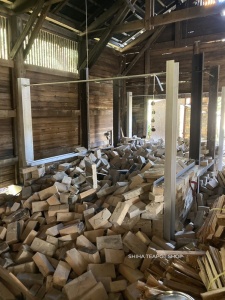
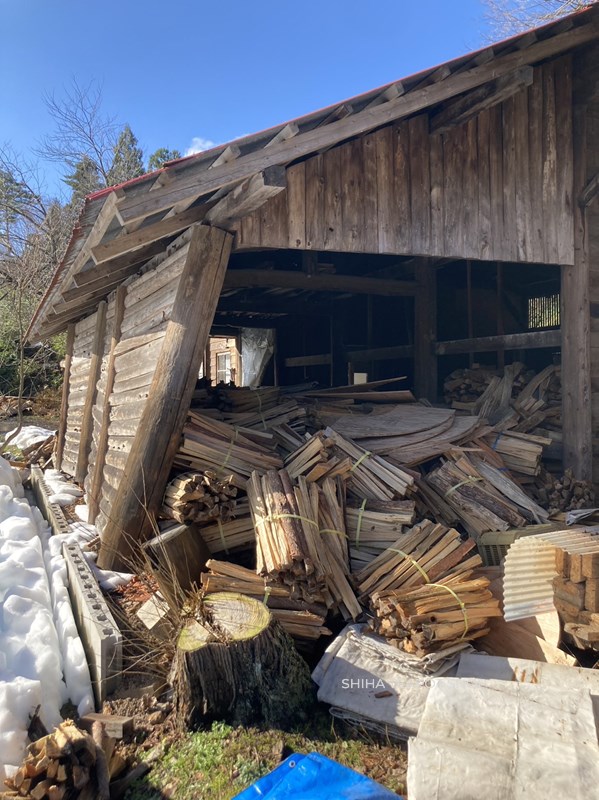
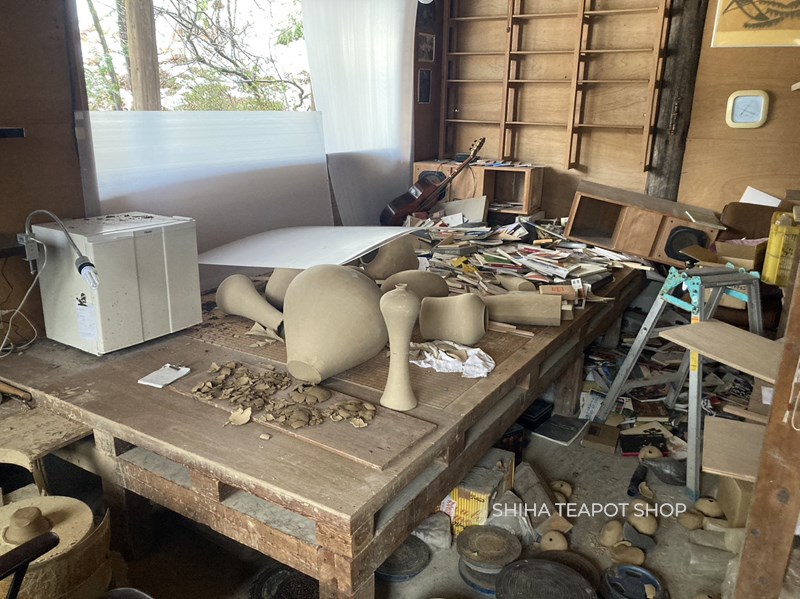
ーーーーーーーーーーーーー
Below are newspaper articles and news about Suzuyaki (Suzu ware).
◆ Jan 17, 2024 “We came here with little by little with hope – but serious damage again”
https://newsdig.tbs.co.jp/articles/-/946564
◆ Jan 19, 2024 “Shinohara Vows for Third Challenge After Another Defeat”
https://www.hokkoku.co.jp/articles/-/1293915
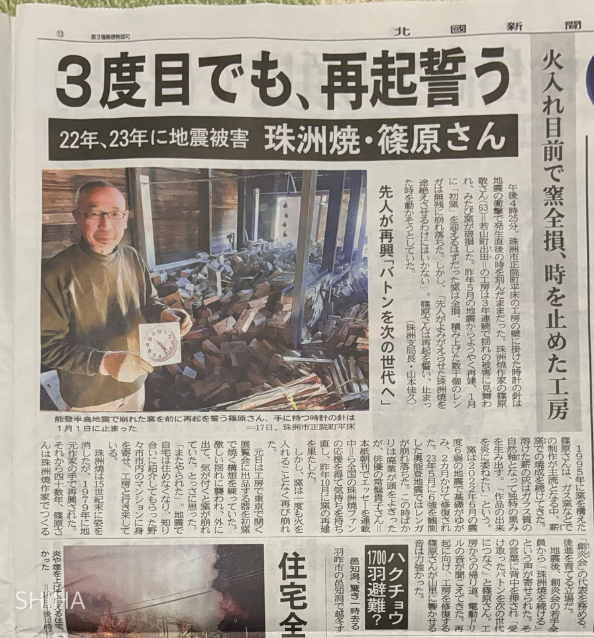
◆ Jan 26, 2024 Kiln and works destroyed “If you give up, my life itself will be wasted.”
https://www.jiji.com/jc/article?k=2024012500765
◆ Feb 27, 2024: All 20 kilns damaged; many messages arrived “we help your rebuilding”
https://www.tokyo-np.co.jp/article/311775
◆ March 1, 2024 Documentary News – Life, Workshop, and Thoughts on the Present and Future of Takashi Shinohara after the Earthquake
◆May 31, 2024 Construction of a temporary workshop at a Suzu pottery kiln begins.
https://www3.nhk.or.jp/lnews/kanazawa/20240531/3020020421.html
◆ July 21, 2024 Temporary Workshop for Suzuyaki Reconstruction Designed by Shigeru Ban with Sufficient Structural Strength
https://www.chunichi.co.jp/article/930737
◆ Sep 1, 2024: Wajima Lacquerware, Suzuyaki… Traditional Industries in Noto Still in Difficulties Eight Months After the Earthquake Production Resumption Remains Challenging
Traditional industries like Suzuyaki remain in a harsh situation. Even securing temporary housing has been challenging, and the path to rebuilding workshops and kilns is still long.
https://www.sankei.com/article/20240901-7DCISR3FDZLGBCYSUTODCREKXY
◆ Oct 21, 2024: Suzuyaki Revived, Flames of Hope – First Kiln Firing Since the Disaster by Artist Group “Soenkai”
With most artists’ kilns and workshops destroyed by the earthquake and compounded by flood damage, they have continued their activities by sharing a public kiln.
https://www.hokkoku.co.jp/articles/-/1553234
◆Nov 26, 2024 Earthquake and Heavy Rain: Ongoing Challenges for the Revival of “Suzuyaki” Pottery
Mid-October: Restoration project started with clearing the collapsed kiln. Volunteers from all over the country cleaned approx. 3,000 bricks in three days.
https://newsdig.tbs.co.jp/articles/mro/1576816
珠洲焼 地震後-3.png)
◆May 5, 2025 Suzuyaki pottery kiln reconstruction work resumes Takashi Shinohara
(Excerpt/Summary of the artilce)
In late April 2025, Takashi Shinohara began reconstruction work on his Yūgi Kiln with the help of volunteers. This is the third attempt at rebuilding the kiln. The restoration work aims to stack 5,000 bricks by August. One of Shinohara’s driving forces is the encounters he has had with volunteers from both Japan and abroad who came to support the effort.
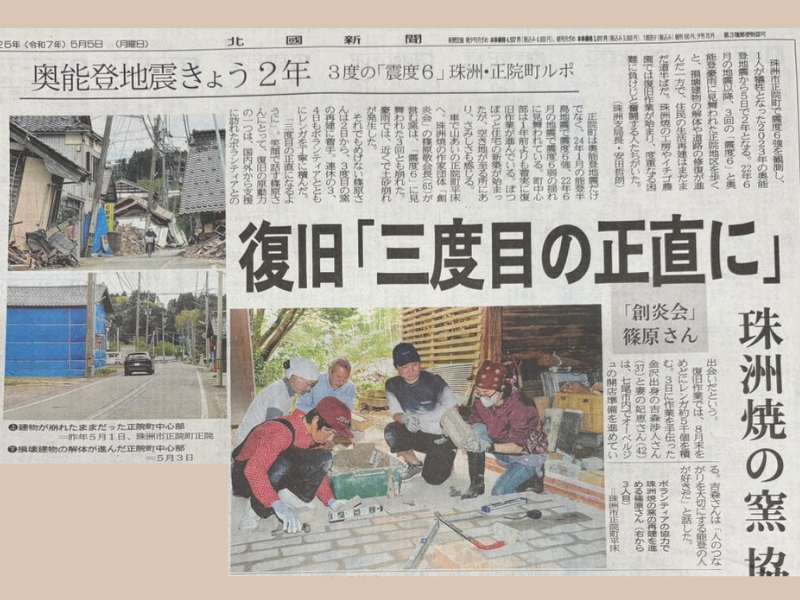
2025 Reconstruction Plan (Shinohara Takashi Kiln) As of Nov 2024
- Before Summer 2025: The goal is to complete the kiln’s construction.
- Fall 2025: The first kiln firing is planned (after completing the production and firing preparations, it is expected to take place in the fall)
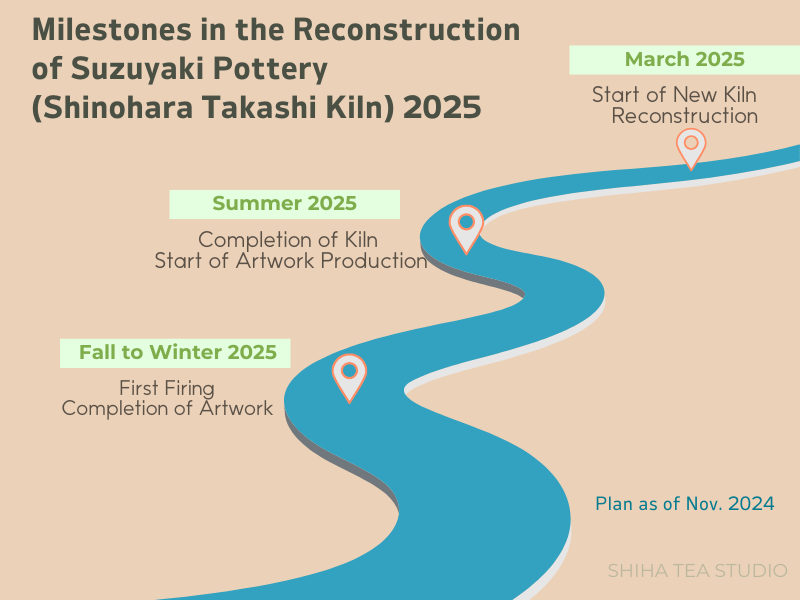
Message from Shinohara Takashi – February 2025
Support and Donation for Suzu City and SUZU Pottery Artist
Information on Financial Support and Donations for Suzu Artist Association and Mr. Shinohara Takashi.
Your consideration and warm support to them will be great hope for them.
■ For Suzu Ware Artists’ Association (珠洲焼創炎会 Souenkai)
How to : Direct Bank Transfer
1. Bank Information (From Japan)
| 北國銀行 (ほっこくぎんこう) 珠洲支店(スズしてん) (普) 28551 名義 能登半島地震義援金 珠洲焼創炎会 (ノトハントウジシンギエンキン スズヤキソウエンカイ) | Name of Bank:THE HOKKOKU BANK,LTD. Name of Branch: Suzu Branch Account Number: 28551 Beneficiary’s Name: ノトハントウジシンギエンキン スズヤキソウエンカイ |
2. Bank Information (From Oversea)
Please refer above “Bank Information (From Japan)” and if you need help for donation, please contact us. We will ask Souenkai.
| Name of Bank:THE HOKKOKU BANK,LTD. SWIFT Code: HKOKJPJT Name of Branch: Suzu Branch Account Number: Beneficiary’s Name: Beneficiary’s Address: |
■ For Mr.Shinohara Takashi
How to : Direct Bank Transfer
1. Bank Information (From Japan)
| 北陸銀行 珠洲支店(スズしてん) (普) 4076402 名義 篠原敬(シノハラ タカシ) | Name of Bank:The Hokuriku Bank, Ltd. Name of Branch: Suzu Branch Account Number: 4076402 Beneficiary’s Name: Shinohara Takashi |
2. Bank Information (From Oversea)
| Name of Bank:The Hokuriku Bank, Ltd. SWIFT Code: RIKBJPJT Name of Branch: Suzu Branch Account Number: 324-4076402 Beneficiary’s Name: Shinohara Takashi Beneficiary’s Address: 41-2 SUTTA WAKAYAMA-MACHI SUZU-SHI ISHIKAWA 927-1233 JAPAN |
Thank you very much for reading and your interest.
Japanese Page may have more information. Please read with translation button.

